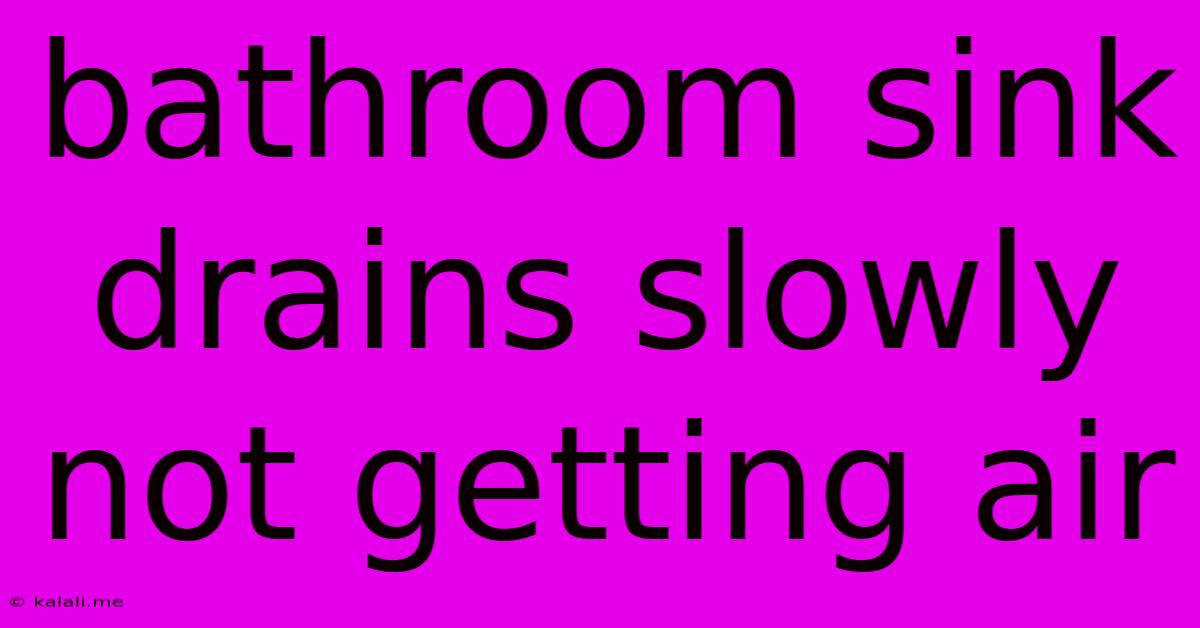Bathroom Sink Drains Slowly Not Getting Air
Kalali
Jun 01, 2025 · 3 min read

Table of Contents
Bathroom Sink Draining Slowly? The Air Gap Solution
Is your bathroom sink draining slower than a snail in molasses? Frustrating, right? A slow-draining sink can be caused by several issues, but one common culprit often overlooked is a lack of proper air circulation – essentially, your drain isn't getting enough air. This article explores this problem, its causes, and how you can fix it effectively. We'll cover simple troubleshooting steps and explore solutions to get that water flowing freely again.
Why is my bathroom sink draining slowly without air?
A slow-draining sink that's not getting enough air is usually a symptom of a blockage or a vent problem. The process of water draining involves more than just gravity; it relies on air pressure equalization. When water rushes down the drain, air needs to replace it in the pipe. If this air exchange is hindered, the water drains slowly, creating a vacuum effect.
Common Causes of Slow Drains with Air Issues:
-
Clogged Vent Stack: This vertical pipe, connected to your drain system, allows air to enter and equalize pressure. If it's blocked with debris, the drain struggles to pull water down. Leaves, small toys, or even pest nests can cause these obstructions.
-
Blocked Drain Pipes: A build-up of hair, soap scum, grease, and other debris in the drainpipe itself directly restricts water flow. This is a very common problem, often addressed with simple drain cleaning solutions.
-
P-Trap Issues: The P-trap, that curved pipe under your sink, is designed to hold water, preventing sewer gases from entering your home. However, a clogged P-trap can severely impede drainage.
-
Dry P-Trap: If your P-trap has dried out (e.g., due to infrequent use), it can also create a blockage and prevent proper air flow.
-
Improper Installation: In some cases, the drain system might be improperly installed, creating air flow restrictions.
How to Fix a Slow-Draining Sink Lacking Air:
Before calling a plumber, try these troubleshooting steps:
-
Check the P-trap: Carefully remove the P-trap (place a bucket underneath to catch water). Inspect it for clogs. Clean it thoroughly with a wire hanger or a drain snake. Reinstall the P-trap securely. Run water to see if the drainage improves.
-
Check the Drain: Pour boiling water down the drain to help melt grease and soap scum. Follow this with a drain cleaner (follow product instructions carefully). Use a plunger to create suction and dislodge clogs. A drain snake (also known as a plumber's snake) can reach further into the pipes to remove stubborn clogs.
-
Inspect the Vent Stack (if accessible): If you can safely access the vent stack on your roof or in your attic, inspect it for blockages. This might require professional help if it's located in a difficult-to-reach area.
-
Pour Water into Other Drains: This can sometimes help equalize the air pressure in the system and get things moving again.
Preventing Future Slow Drains:
-
Regular Cleaning: Regularly clean your drain with baking soda and vinegar, or a commercial drain cleaner. Remove hair and debris from the drain opening regularly.
-
Use Drain Strainers: Install drain strainers to prevent hair and debris from entering the drain in the first place.
-
Avoid Pouring Grease Down the Drain: Grease solidifies in pipes, causing clogs.
-
Proper Ventilation: Ensure proper ventilation in your bathroom to avoid moisture build-up and the subsequent development of clogs.
When to Call a Plumber:
If these simple steps don't resolve the issue, it's time to call a professional plumber. They have the tools and expertise to diagnose and fix more complex drain problems. They may need to use specialized equipment to clear stubborn clogs or identify problems in the vent stack or main drain line.
Addressing a slow-draining sink often involves understanding the crucial role of air pressure in the drainage system. By following these tips, you can often restore efficient drainage without the expense of a plumber. Remember prevention is key!
Latest Posts
Latest Posts
-
Can A Minor Travel With An Expired Passport
Jun 03, 2025
-
Why Isnt Beauty A Concept For Kant
Jun 03, 2025
-
Why Cant You Subtract 2 From 2x
Jun 03, 2025
-
What Do Turkey Liver Look Like
Jun 03, 2025
-
Measures In Between Music That Switches Key Signature
Jun 03, 2025
Related Post
Thank you for visiting our website which covers about Bathroom Sink Drains Slowly Not Getting Air . We hope the information provided has been useful to you. Feel free to contact us if you have any questions or need further assistance. See you next time and don't miss to bookmark.